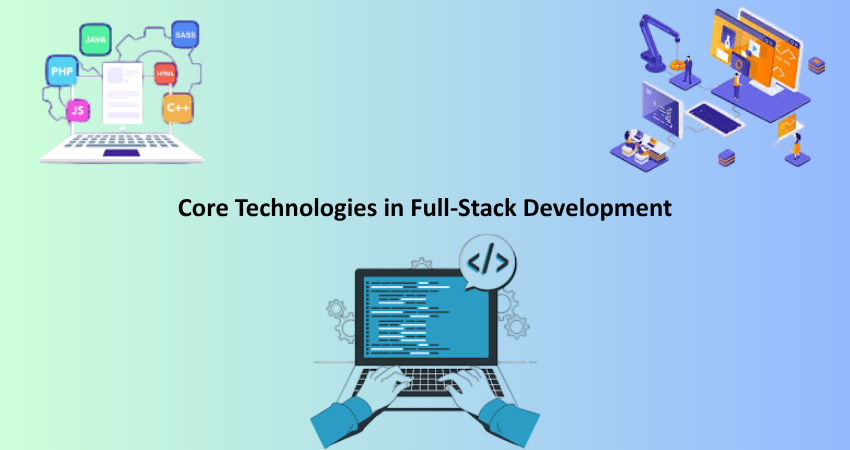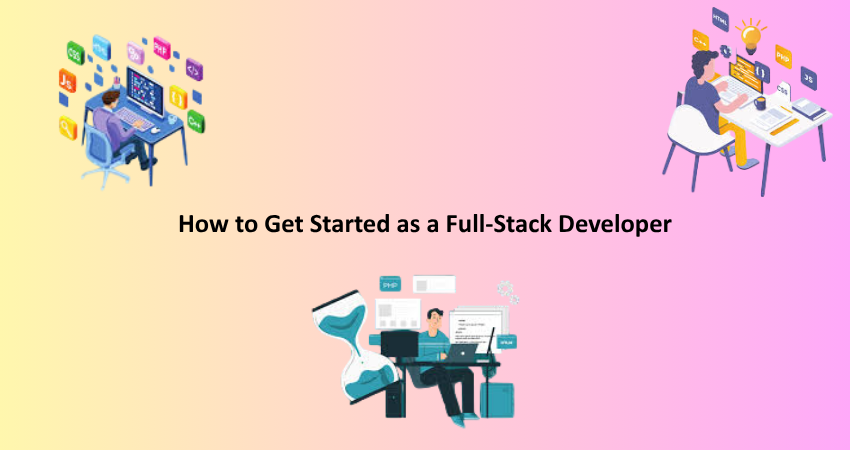
Introduction
In the contemporary world of fast-paced technology, the words “full-stack development” are seen everywhere, from job ads to technology blogs to coding boot camps. To some latecomers in that field, the name might sound a bit technical or intimidating. Nevertheless, full stack development can easily be understood with simple breakdowns. Essentially, full-stack development means working on the front-end (what users see and do) and the back-end (the server, database, and logic behind the scenes) of a web application. It is a skill which makes developers quite flexible and hence valuable at all stages of web and software development.
Every year, the need for full-stack developers grows much more. Basically, startups keep hiring such professionals since they can save money and communicate with just one person across the board by hiring those who can operate in all dimensions of a project. Now, large companies employ such kind of developers in order to understand the entire system very well, making it easier for them to draw together everything into one and problem-solving in between different teams. This article shall explain some of the landmarks full-stack development takes in. It will lay out achievable common and emerging technologies of this career domain and how to take the next step into it, especially when an applicant has no prior experience with coding.
Understanding the Basics of Full-Stack Development
What Does “Full-Stack” Mean?
The phrase “full stack” is derived from an entire idea of software stack, which means all these technologies that are employed for an assembly corresponding to web or software application. “stack,” Usually involves layers: user interface, application logics, and databases. To say that a developer is full-stacked is to say he or she works across all these layers and is capable of developing and maintaining everything from the layout and design-such as those which front the website-to the databases and servers that power up its functionality.
What a full-stack developer can do is like what a contractor can do; it’s like a general contractor for a house. As a contractor handles everything from plumbing to electrical to carpentry to finishes, so the full-stack developer does coding with respect to all the user interfaces and server-side components. It doesn’t mean the person knows everything in every technology but how those different stacks interact and jumps in whenever. This makes them very adaptable and useful in almost any kind of development team due to their ability to work through the complete lifecycle of web applications.
Front-End vs. Back-End: A Clear Distinction
However, if one would like really to learn full-stack development, then rather split full-stack development into front-end and back-end. The portion of web development that involves computers interacting with the above is front-end development. Front ends comprise such things as layouts, colors, fonts, buttons, forms, and the general user experience. Then generally popular technologies for front-end development include HTML, CSS, and JavaScript, with frameworks such as React, Angular, and Vue.js. A front-end developer has to make sure that user interface attractive, functional, and responsive for different devices.
Back-end development, on the other hand, is what happens outside the viewing window when a web application is used. It covers things such as database management, user authentication, processing of payment, and other essential core functions required by the user, which they do not see. Some back-end technologies include programming languages like Python and Java, Ruby, Node.js, PHP, and databases like MySQL, PostgreSQL, and MongoDB. Whereas the front-end developer is tasked with ensuring that the web browser interface is appealing, functional, and responsive to several devices, the back-end developer works to ensure that everything functions smoothly in the background, with a secure and efficient data flow.
Core Technologies in Full-Stack Development

Front-End Technologies and Frameworks
The front end is the portion of the application that a user interacts with. Thus, it should be imperturbable with terrific looks but also pretty fast when it responds to user action. A full-stack developer needs good knowledge of front-end technologies. HTML is a Hypertext Markup Language, CSS is a layout control of contents, and JavaScript makes things interactive. These three things are the core of any web page. But modern web development isn’t limited to these three.
Frameworks and libraries such as React, Angular, and Vue.js are what take front-end development to the next level. This would give structure in ways to build complicated user interfaces by reusing components. React, ushered in by Facebook, is the hottest contender to date in frontend libraries; it holds the torch for flexibility and performance. These tools make it easy for developers to manage user interaction, state, and layout, hence creating a smoother experience for the users. A full-stack developer had to know these tools to bring out a modern, responsive web interface.
Back-End Languages and Databases
Front-end technologies deal with the user side, while back-end tools deal with all that is not seen by users. A full-stack developer is supposed to know at least one back-end programming language. Node.js is preferred by JavaScript developers as it enables them to write in the same language for both client and server. Python is another very popular choice due to its ease of use and the potential power that comes bundled with its frameworks, such as Django and Flask. Other popular choices include Ruby with Ruby on Rails, Java, and PHP.
Databases are equally important. They also store user data, content, and settings for your application. There are basically two main kinds of databases: relational (like MySQL, PostgreSQL) and non-relational (like MongoDB). Full-stack developers should know how to design database schemas, write queries, and interact with the database via their back-end code. The knowledge states here concerning CRUD operations (Create, Read, Update, Delete), indexing, and data relationships are the lifeblood for super-duper scalable applications.
Tools and Platforms Used by Full-Stack Developers
Development Environments and Version Control
An efficient working environment is a need for any full-stack developer. Generally, such an environment consists of a code editor (Visual Studio Code) and a local server to test applications while in the development stage. A perfect development environment increases speed of coding, reduces errors, and keeps the productivity levels up. Other than editors, command-line tools and terminal-based workflows are often part of the daily work routine. Knowing how to effectively use and manage these becomes a part of being a productive developer.
Version control is another essential, with Git as the most used system. With Git, developers can track changes in their code, collaborate with others, and revert back if something goes wrong. Git-based repositories in the cloud, such as GitHub or GitLab, enable code to be stored for sharing and review. Understanding Git workflows, branching, merging, and making pull requests is essential in the present-day collaborative development environment. This way, it will be sure that the project is organized and traceable and safe against data loss.
Deployment, Hosting, and DevOps Basics
It’s quite worth mentioning that building an application is just one half of the process and making it deployable for users to see it live is the other half. These important aspects of deployment require knowledge from full-stack developers about hosting their applications, which can involve traditional web hosting or more recent cloud platforms such as AWS, Azure, or Google Cloud or somewhat PaaS ones like Heroku and Vercel.
Now comes in the role of DevOps tools and practices. Continuous integration, continuous deployment, Docker, and Kubernetes form a large part of that. While at the beginner level, full mastery over all these tools will not be expected, what will definitely set you apart is knowledge of how deployment workflows work, the setup of environment variables, and server configurations. DevOps will provide tools to automate repetitive tasks, streamline application updates, and guarantee uptime and security for applications running in production.
Benefits and Challenges of Being a Full-Stack Developer
Advantages of the Full-Stack Role
It offers a life of versatility as a full-stack developer. Because they can work on all parts of an application, they become very flexible with any project and any team constellation. Such flexibility helps lead to quicker problem-solving, smoother communication across departments, and quite efficient development cycles. This makes a developer self-sufficient and freely working on freelance or solo projects without the need to depend on other people to fit in specific parts of an application.
Another critical aspect would definitely be employment. Being pretty much fully proficient on both the front and back end therefore makes a full-stack developer so much more valuable, and hence less likely to be found easily over the years and so worth a lot more in salary. In fact, most startups always want a developer who can do multiples roles for which they will not pay too much. Even when you move to larger organizations, the whole idea is appreciated because such kinds of people understand systems entirely, allow others to mentor them, propose holistic solutions, and lead cross-functional initiatives.
Common Challenges and Misconceptions
There are many advantages to being a full-stack developer, but there are challenges that come along with it too. The first challenge would be the expectation that one should be an expert in everything. Full-stack developers are expected to have a broad knowledge across the stack, but they are rarely experts in every technology. Trying to get too adept at both front-end and back-end can easily lead to burnout or a comparatively shallow understanding in important areas. It is important for these developers to know their strengths and work together with other specialists to share knowledge on terms requiring deeper expertise.
Also, with the ongoing technological changes, being a full-stack developer poses another challenge. The front-end and back-end domains are the ones that change rapidly with the introduction of new frameworks, languages, and tools practically every day. All the while, it is expected that a full-stack developer keeps learning and improving upon what is new. Sometimes overwhelming, but for those with a passion for continuous learning, this is a true thrill. Maintain a focus on fundamentals that last past specific tools, being discerning as to which new technologies will be embraced based on the needs of each respective project.
How to Get Started as a Full-Stack Developer

Learning Paths and Educational Resources
Ways into full-stack development abound. Others pursue a formal qualification through a computer science degree, and others opt for self-paced learning through online platforms such as freeCodeCamp, Codecademy, Udemy, or Coursera. Coding boot camps are another approach, where immersion training programs are focused on practical, job-ready skills. For the express entry into the sector, these schools unite an entire program with both front-end and back-end technologies into a much shorter course duration.
After all, whatever route you take, the important step is to get your hands dirty: create small projects that are both front- and back-end, say, a personal blog, or a task manager, or a simple e-commerce site. You might need them to reinforce concepts and demonstrate what you can do to future employers. Document your learning process and showcase it on as many platforms as you can, such as GitHub and personal portfolio sites. Consistency, curiosity, and real-world application are more important than credentials when it comes to breaking into the field.
Building Projects and Gaining Experience
Learning by doing is the best way to cement one’s knowledge of full-stack development. Start with simple applications employing HTML, CSS, and JavaScript on the front-end and Node.js or Python on the back-end. Gradually introduce advanced features—user authentication, APIs, and responsive design. Each project should address a real-world problem or demonstrate a particular ability—for example, working with databases or visualizing data.
Once you get the hang of the basics, you could advance further with open-source contributions or group projects with fellow learners. This environment nurtures the learning of best practices, clean coding, team efforts, and workflows. Getting freelance gigs or internships would offer hands-on opportunities for development as well. In the end, employers prefer someone who identifies a problem and takes the initiative to solve it. In that regard, understanding freelancing, internships, and enhancing your portfolio will build the confidence and skills for working as a full-stack developer.
Conclusion
Indeed, a full-stack developer seems to be one of the most attractive and most demanding professions. One needs to add in equal measure creativity and technical know-how. This means full-stack developers also understand both front and back ends of web applications. This knowledge would give a complete picture and help them develop solutions that not only are working but also manageable and user-oriented. A full-stack developer is really a journey that requires commitment, as well as a continuous learning attitude, since it would open doors to many spaces in different industries and at different roles in development.
To put it starkly, a full-stack developer is a very technical and talented individual who can work on everything from user interface design all the way down to server-side logic. Full-stack development increases the professional horizon and skills of individuals, rather generalizing them in an extremely digitized contemporary world. With the right attitude, resources, and persistence, you should be able to learn the full stack and then impact significantly in an ever-growing technology space.